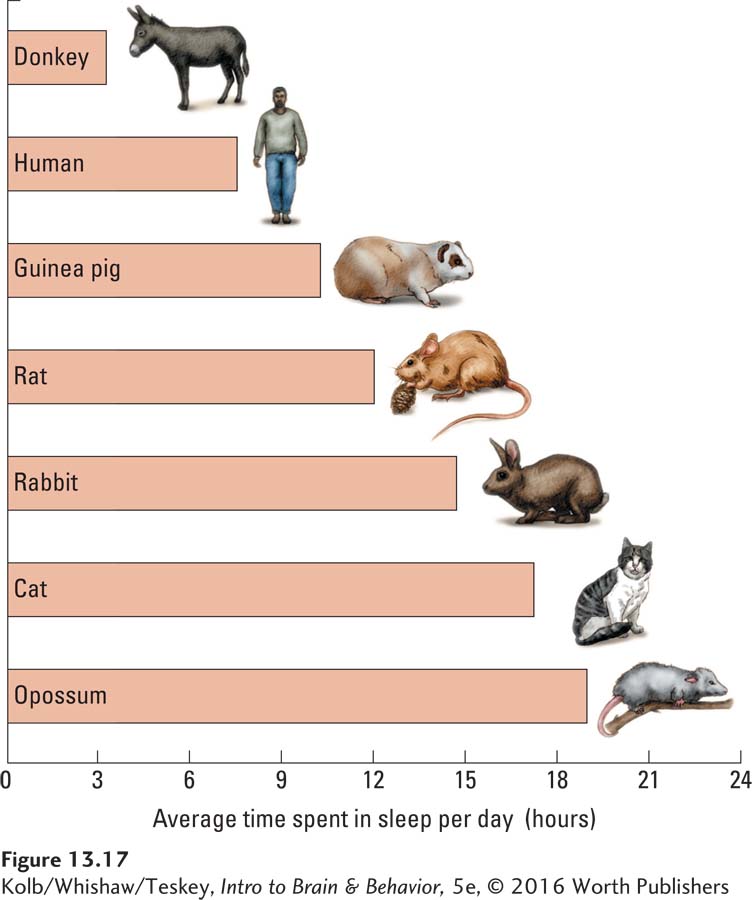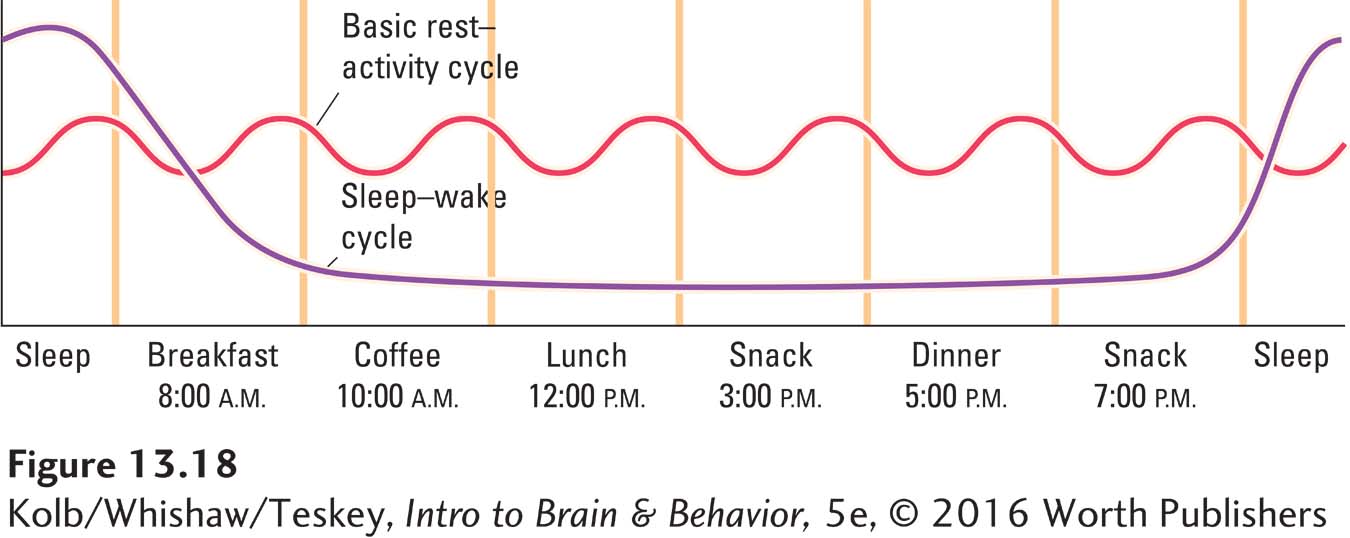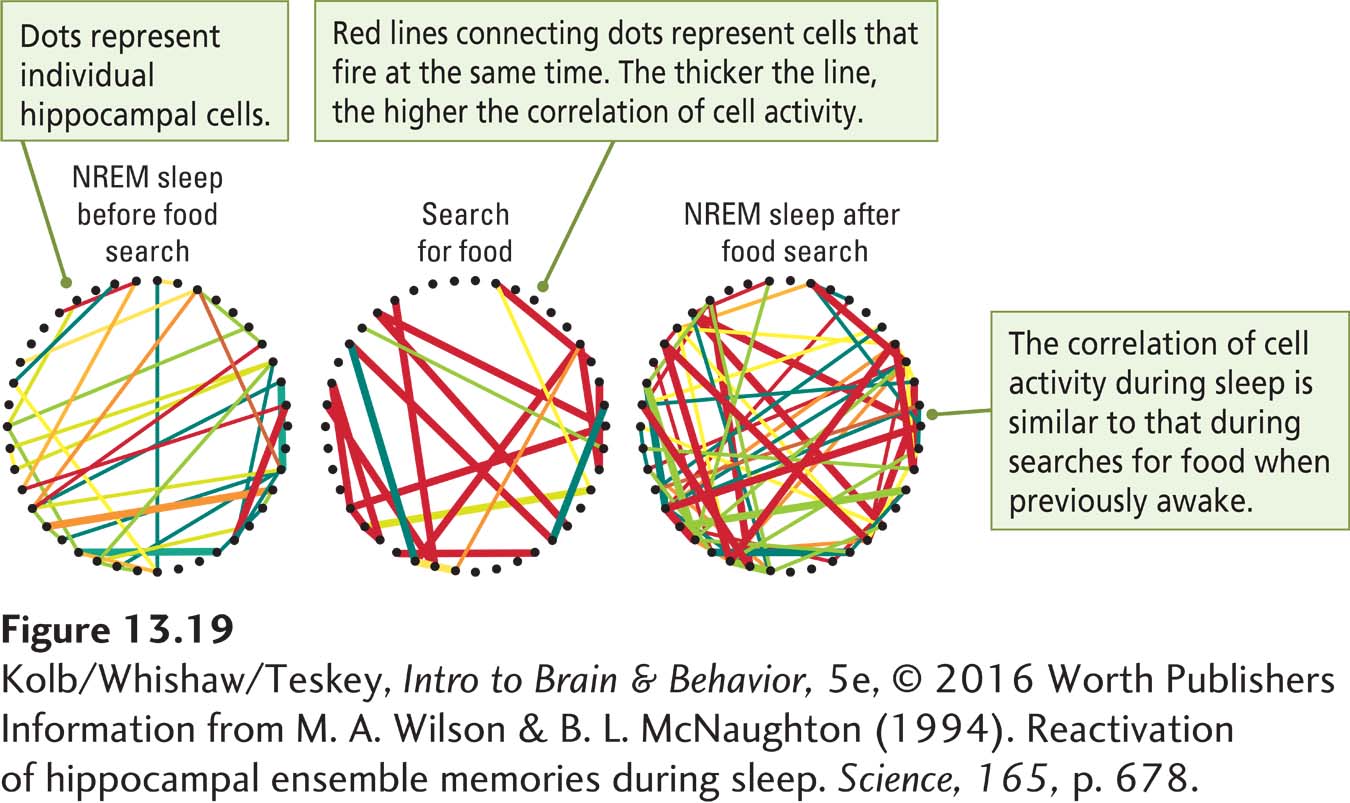13-4 What Does Sleep Accomplish?
Sleep is not a passive process that results from a decrease in sensory stimulation. Findings from sensory deprivation research reveal that when participants are isolated in quiet bedrooms, they spend less time asleep, not more. These results do not support the idea that sleep sets in for lack of anything else to do. Here we consider three contemporary explanations for sleep: as adaptive, as restorative, and as supportive of memory.
Sleep As a Biological Adaptation
Many lines of evidence argue that sleep is a biologically adaptive behavior influenced by the ways a species has evolved to interact with its environment:
Sleep serves as an energy-
conserving strategy for coping with times when food is scarce. Each animal species gathers food at optimal times and conserves energy the rest of the time. If the food that a species eats has a high nutrient value, the species can spend less time foraging and more time sleeping. Whether a species is predator or prey influences its sleep behavior. A predator can sleep at its ease; the prey’s sleep time is reduced because it must remain alert and ready to fight or flee at unpredictable times (Figure 13-16).
Strictly nocturnal or diurnal animals are likely to sleep when they cannot travel easily. Dement proposed this colloquially: “We sleep to keep from bumping into things in the dark.”

Much about animals’ sleep patterns are consistent with the adaptive explanation. Figure 13-17 charts the average sleep time of some common mammals. Herbivores, including donkeys, horses, and cows, spend a long time collecting enough food to sustain themselves. Relatively short sleep time for them is adaptive. Because they are also prey, not sleeping much is adaptive, as they watch for predators. Carnivores, including domestic cats and dogs, eat nutrient-

The behavior of some animals does appear odd, so understanding any animal’s sleep behavior requires understanding its natural history. Opossums, which spend much of their time asleep, may have specialized in energy conservation as a survival strategy. We humans are average among species in our sleep time. As we are omnivores, not subject to overwhelming predation, our sleep is intermediate between that of herbivores and carnivores.
Sleep can contribute to energy conservation. During sleep, energy is not being expended in moving the body or supporting its posture. The brain is a major energy user, so switching off the brain during sleep, especially NREM sleep, conserves energy. The decline in body temperature during sleep is an adaptive energy-
A good explanation of sleep must account not only for sleep but also for NREM and REM sleep. Before the discovery of REM sleep, Kleitman suggested that animals have a basic rest–
As illustrated in Figure 13-18, the behavior of adult humans does suggest that activity and rest are organized into 90-

Kleitman proposed that the BRAC rhythm is so fundamental that it cannot be turned off. Accordingly, for a night’s sleep to be uninterrupted by periodic waking (and perhaps snacking), the body is paralyzed and only the brain is active. An analogy: rather than turning off your car’s engine when you’re stopped at a red light, you apply the brakes to keep the idling car from moving. For REM sleep the atonia that paralyzes movement is the brake.
Sleep as a Restorative Process
In Macbeth’s description of sleep Shakespeare illustrates in words the idea that sleep has restorative properties:
Sleep that knits up the ravell’d sleave of care,
The death of each day’s life, sore labour’s bath,
Balm of hurt minds, great nature’s second course,
Chief nourisher in life’s feast. —Act II, scene 2
Sleep Deprivation Studies
We can understand the idea of sleep as a restorative from our personal perspective. Toward the end of the day we grow tired, and when we awaken from sleep, we are refreshed. If we do not get enough sleep, we become irritable. One hypothesis of sleep as restorative proposes that the chemical events that provide energy to cells are reduced during waking and replenished during sleep.
Even so, fatigue and alertness may simply be aspects of the circadian rhythm and have nothing at all to do with wear and tear on the body or depletion of its essential resources. To evaluate whether sleep is essential for bodily processes, investigators have conducted sleep deprivation studies. These studies have not clearly identified any essential function for sleep but rather point to multiple physiological and cognitive functions altered by various degrees of sleep deprivation (Elliott et al., 2014).
Dement participated as an observer in one case study on sleep deprivation that illustrates this point. In 1965, as part of a science fair project, a high school student named Randy Gardner planned to break the world record of 260 hours (almost 11 days) of consecutive wakefulness with the help of two classmates who would keep him awake. Gardner did break the record, then slept for 14 hours and reported no ill effects. Given concerns about the deleterious effects that sleep deprivation has on health, Guinness World Records no longer records wakefulness records.
Dement reported that Gardner hallucinated and had cognitive and memory lapses during his period of sleep deprivation. These negative effects did not last. Reviews of sleep deprivation research are consistent in concluding that at least limited periods of sleep deprivation produce no marked physiological alterations.
Sleep deprivation does not seem to have adverse physiological consequences, but it is associated with poor cognitive performance. Performance on tasks that require attention declines as a function of hours of sleep deprivation. Irregular sleep can contribute to metabolic syndrome, described in Clinical Focus 13-1. Finally, sleep deprivation figures in accidents at work and on the road. The sleep deprivation deficit does not manifest itself in an inability to do a task, because sleep-
A confounding factor in evaluating sleep-
REM Sleep Deprivation
Some studies have focused on the selective benefits of REM sleep. To deprive a participant of REM sleep, researchers allow participants to sleep but awaken them as REM sleep begins. REM-
Participants show an increased tendency to enter REM sleep in subsequent sleep sessions, so awakenings must become more and more frequent.
After REM deprivation, participants experience REM rebound, showing more than the usual amount of REM sleep in the first available sleep session.
Because most sleep studies are of relatively brief duration, capturing potential long-
Section 6-2 reviews the full spectrum of antidepressant drugs.
Two kinds of observations, however, argue against effects of prolonged or even complete REM sleep deprivation. Virtually all antidepressant drugs, including MAO inhibitors, tricyclic antidepressants, and SSRIs, suppress REM sleep either partly or completely. The clinical effectiveness of these drugs may in fact derive from their REM-
In several reported cases lower-
Sleep and Memory Storage
The suggestion that sleep plays a role in memory dates back over a century, and in the interval a lot has changed with respect to our understanding of memory and of sleep. Investigators now know of two general categories of memory. Episodic memory includes conscious information such as our autobiographical memories and knowledge of facts. Implicit memory includes unconscious processes such as motor skills learning. Within these categories specific types of memory include spatial, emotional, verbal, even immune system memory. Investigators also know that during the various stages of sleep many EEG and neuronal events, biochemical events, and genetic events take place. Thus the central challenge for sleep-
Section 14-1 expands on the workings of explicit and implicit memory systems.
Investigators also know that storing memories takes time. Memory is proposed to have at least three phases: labile, consolidation (storage), and recall. During the initial labile phase, as a memory is encoded, it is fragile and must compete with existing memories and the addition of new memories. The consolidation phase forges a relatively permanent representation of the memory; it depends upon biochemical and genetic activity that underlie structural changes in the nervous system. The recall phase puts the memory to work at some future time and also integrates it into existing memory stores.
Research on the role of sleep in memory focuses on the latter two processes, consolidation and recall, and is conducted within the framework of three theories: multiple process, sequential process, and storage process. Multiple process theories propose that different kinds of memory are stored during different sleep states. Sequential process theories propose that memory is manipulated in different ways during different sleep states. For example, one sleep state erases older competing memories, while another sleep state stores the new memories. Storage process theories propose that brain regions that handle different kinds of memory during waking continue to do so during sleep. The advantage is that sleep offers a state relatively free from the competition of new waking experiences.
Each theory of memory and sleep has generated volumes, but the remainder of this section focuses on experimental demonstrations of sleep’s role in the general memory categories of explicit and implicit memory storage during sleep.
NREM Sleep and Explicit Memory
Figure 7-8 shows the classes of place cells and their directional selectivity.
Gerrard and colleagues (2008) used a method which had found that many hippocampal cells fire when a rat is in a certain location in an environment. These place cells are relatively inactive until the rat passes through that place again. Recordings from as many as 100 cells at the same time in three conditions—

This result suggests that the memory of the previous food-
REM Sleep and Implicit Memory
To determine whether humans’ dreams are related to memory, Pierre Maquet and his coworkers in Belgium (2000) trained participants on a serial reaction task. The investigators observed regional blood flow in the brain with PET scans during training and during REM sleep on the subsequent night. The participants faced a computer screen displaying six positional markers and were instructed to push one of six keys when a corresponding positional marker was illuminated. They did not know that the illumination sequence was predetermined. This exemplifies an implicit memory task in which a motor skill is mastered.
Consequently, as training progressed, the participants indicated that they were learning by the fact that their reaction time improved during trials in which one positional marker was correlated with a preceding marker. On PET scan measures of brain activation, a similar pattern of neocortical activation appeared during task acquisition and during REM sleep (Figure 13-20). On the basis of this result Maquet and coworkers suggest first that the participants were dreaming about their learning experience and second that replay during REM strengthened the task memory. Research in which participants are given a language task that contains hidden rules finds that sleep also strengthens this implicit rule learning (Batterink et al., 2014). Thus, much rule learning in both motor and cognitive domains likely is strengthened during sleep, including REM sleep.

Storing Memories During Sleep
Although evidence shows that memory strengthens during sleep, less clear is whether the neural and molecular changes that support sleep memory storage are similar or different from those that store memory during wakefulness. Researchers are addressing this question in innovative animal models of sleep. Nelini and coworkers (2012) studied spatial memory formation in chicks, a species in which such memories are stored mainly in the right hemisphere. Chickens, like many bird species, alternate sleep in each hemisphere, and the researchers showed that after a learning experience, the right hemisphere displayed more sleep than did the left hemisphere. Birds’ selectivity in hemispheric sleep opens up the possibility of comparing plastic changes between the hemispheres as a way of understanding genetic, biochemical, and plastic changes associated with memory formation.
The fruit fly Drosophila also offers insights into the effects of sleep on memory and on plasticity (Dissel et al., 2015). These researchers identified a variety of mutations that disrupt memory formation and plasticity and found that the memory disruptions decrease after sleep. Slight increases in ambient temperature put one mutant strain of fly to sleep, which greatly aided the research. For this strain a learning task can be followed by various sleep doses induced by manipulating room temperature. A finding of this research is that the same group of neurons that enhance memory are those that induce sleep. This finding suggests a causal link between memory and sleep: Drosophila sleeps to remember! Generalizing this finding to us humans suggests that learning will make us tired.
13-4 REVIEW
What Does Sleep Accomplish?
Before you continue, check your understanding.
Question 1
Sleep is proposed to occur as a(n) ____________ adaption, as a(n) ____________ process, or as an aid in storing ____________.
Question 2
____________ memory is associated with NREM sleep, and ____________ memory is associated with REM sleep.
Question 3
In rats performing a spatial task, correlations develop between ____________ firing in the hippocampus that is then replayed in ____________ sleep.
Question 4
When you are sleep-
Question 5
Describe a difficulty in relating memory formation to sleep.
Answers appear in the Self Test section of the book.